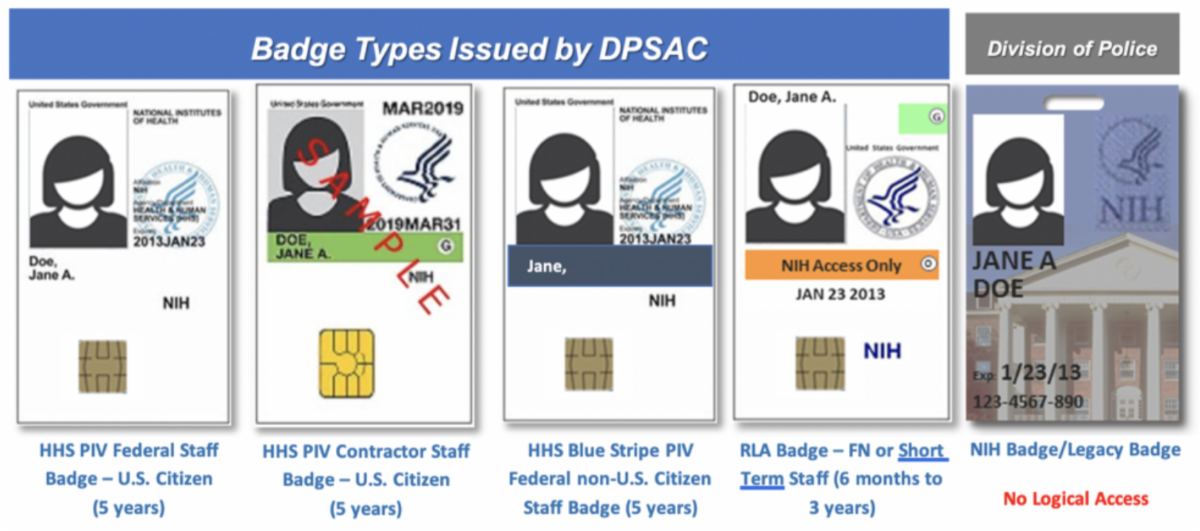Position Classifications
Determining a candidate's classification accurately when registering him/her into the NIH Enterprise Directory (NED) is a very important first step in the badging process, as this ensures that the candidate is vetted appropriately and issued the correct badge to allow them appropriate access at the NIH. Please note that determining a position classification should not be confused with the position designation tool (PDT).
In short, the type of background investigation/badge requested is determined by:
1. Candidate's position classification in NED
2. Their citizenship status
3. Duration of access needed (i.e., greater/less than 6 months, up to 1 year, up to 3 years or up to 5 years)
Please find the complete list of spotlights regarding the 16 position classifications to help you determine the correct classification for an individual. Each classification governs whether the candidate will be entered into NED, the type of background check to be administered, who will conduct the background check (DPSAC or the NIH Police) and the lifecycle of the badge (i.e., less than six months, up to a year, up to 3 years or up to 5 years).
Badge Types
After determining a candidate's classification, the candidate will be eligible for one of the three types of badges (also listed in the "Badging Authority Chart") below:
1. Personal Identity Verification card (PIV Card)
2. Restricted Local Access (RLA) badge
3. NIH Legacy ID badge
Candidates needing long-term (greater than 6 months) physical & logical access are subject to Prescreening & will require a background investigation. These candidates will receive either:
- Personal Identity Verification (PIV) badge (U.S. Citizens)
- Restricted Local Access (RLA) (Non-U.S. Citizens/under 3 years U.S. Residency)
- Blue Stripe PIV (Non-U.S. Citizens/over 3 years U.S. Residency)
Candidates needing a short-term (less than 6 months) physical & logical access are subject to a fingerprint check (SAC) and will receive the short term RLA badge.
Badging Authority Chart

Please note: DPSAC does NOT process Patients, Extended Visitors, Service Providers, Vendors and Construction Workers.
For a better understanding of the different badge types, please see the Badge Classification chart.
RLA Badges
The RLA Badge is a non-PIV Alternative Identity Credential that provides both physical and logical (NIH Network and IT systems) access. The following candidates are not eligible for an HHS Personal Identity Verification (PIV) and will instead be processed for a Restricted Local Access (RLA) Badge:
- Short Term NIH Staff (individuals who will be employed by NIH less than six months)
- Summer Students (RLA badges issued to these individuals expire on September 30 of the year issued)
- Foreign Nationals (who have resided in the U.S. for less than 3 years)
Purpose of the RLA Badges
NIH worked with HHS to develop the RLA Badge in order to meet HSPD-12 security guidelines for individuals who do not qualify for an HHS ID Badge (PIV Card). The RLA Badge is an NIH-issued smart card that can be used for physical access to NIH facilities and logical access to NIH information systems. It looks similar to the HHS ID Badge and contains an embedded computer chip and displays an orange stripe.
Badge Sponsorship
Please be sure to understand how an AO needs to complete Badge Sponsorship, as DPSAC Prescreening does not start until the AO completes Badge Sponsorship in NED (and until DIS validation is complete for non-immigrant foreign nationals). It is important that the information above provided by the AO is correct before DPSAC can begin prescreening for the candidate. For more information, please read the section on "Administrative Sponsorship" under DPSAC Process Overview on our website.
